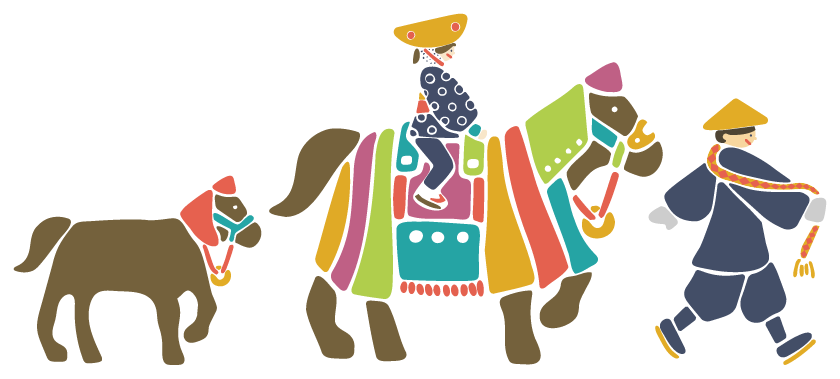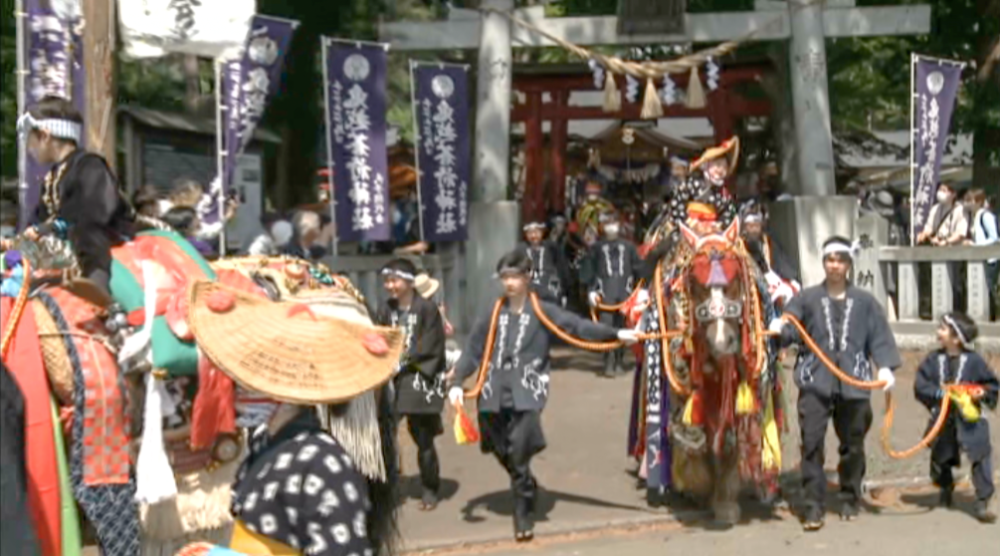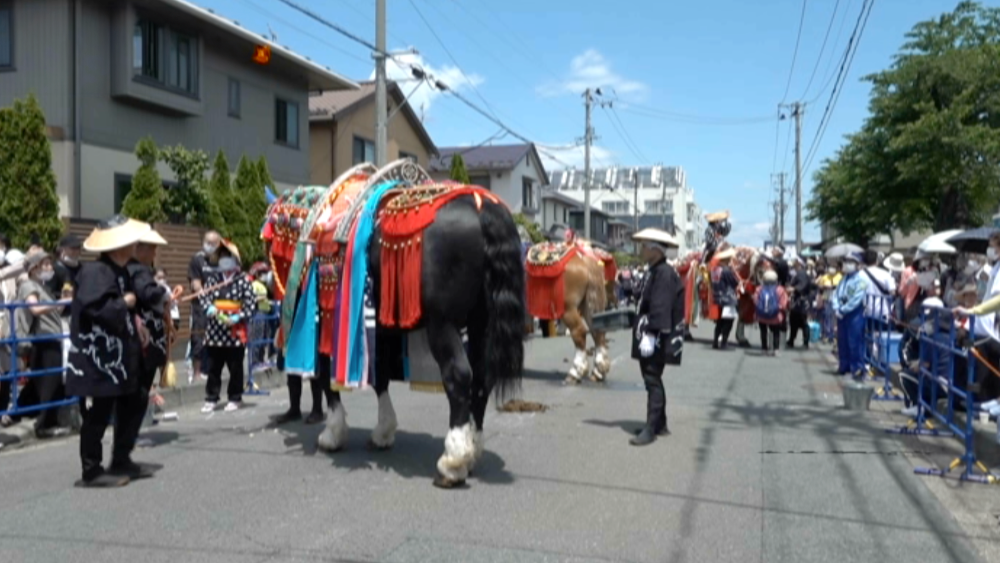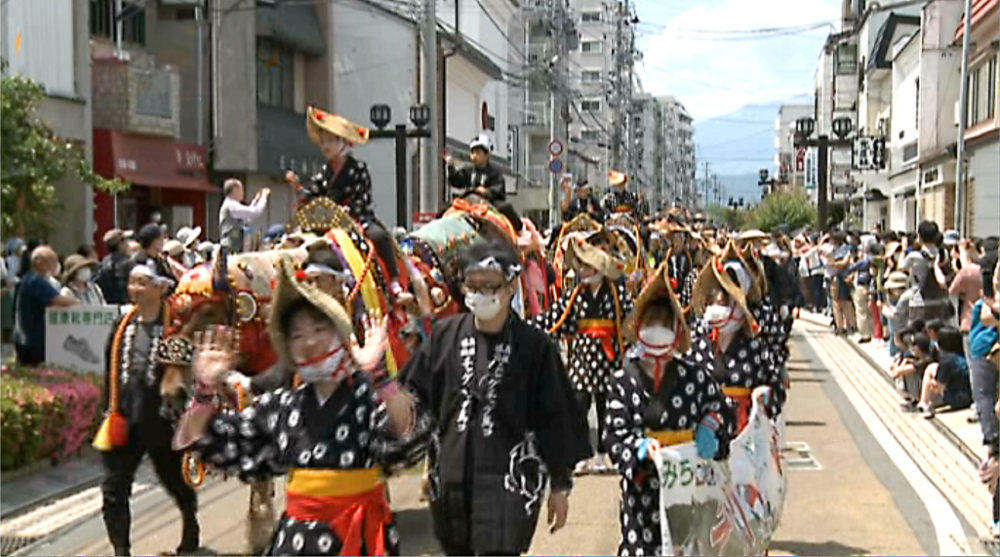marching event

About the Event
Chagu Chagu Umakko is held annually on the second Saturday of June. Originally, it took place on May 5th of the lunar calendar, but due to overlapping with the busy farming season, it was changed to June 15th in 1958. Since 2001, the event has been scheduled on the current date to allow for more horses to participate, and more people to watch.
The purpose of Chagu Chagu Umakko is to express gratitude to horses used in agricultural work, by dressing them up once a year and acknowledging their efforts, and some of those participating are even actual workhorses used in logging operations.
About 60 workhorses, adorned in colorful attire and accompanied by the sounds of ringing bells, march approximately 14 kilometers from Onikoshi Sozen Shrine in Takizawa (adjacent to Morioka), passing through nine locations before reaching Morioka Hachimangu Shrine. Each horse is accompanied by two people–one attendant, and and one child who rides the horse.
On June 11th, 2023, the Chagu Chagu Umakko parade was held for the first time in three years since the Covid-19 pandemic began, and attracted a record-high attendance of 184,000 spectators.

Viewing
Traffic regulations and changes to parking arrangements will be in effect during parade day. See the parade route map for further details.
① Onikoshi Sozen Shrine
Onikoshi Sozen Shrine is located in Ukai Sotokubo, Takizawa, Iwate. The location is known as a sacred place for the Chagu Chagu Umakko festival, and is where the procession begins.
Every year on New Year’s day, the Chagu Chagu Umakko parade makes a pilgrimage to Onikoshi Sozen Shrine, which is said to house the guardian deity of horses, to pray for household safety and abundant harvests for the year. The sight of these horses, adorned in magnificent costumes, visiting the solemn precincts of the shrine during the New Years season offers a different charm from the Chagu Chagu Umakko event held in early summer.

② Takizawa City Hall
Chagu Chagu Umakko marches past the brick exterior of Takizawa City Hall. And across the street, at Big Roof Takizawa, there are annual events such as a horse petting zoo, Chagu Chagu Umakko poster exhibitions, local folk arts performances such as the Takizawa Koma Odori dance, and gift sales, as well as food stalls and trucks. The festival aims to deepen understanding and familiarity with Chagu Chagu Umakko, among both local residents and tourists alike. After watching the Chagu Chagu Umakko parade pass by Takizawa City Hall, come and hang out at Big Roof Takizawa!

③ Aoyamacho & Morioka Fureai Oibaba
Morioka Fureai Oibaba Plaza is a brick building located behind the Morioka Prefectural Gymnasium. Constructed in 1909 amid calls for strengthening the military during World War I, it was built as an indoor training ground for cavalry units to use as a place for horse training during inclement weather.
Today, it is preserved as a historical building and serves as a multipurpose facility for events, sports, and community gatherings. The Chagu Chagu Umakko parade takes a rest here and then continues its procession through this nostalgic corner of Aoyama, where traces of the past still remain.

④ Yugaose Bridge & Asahi Bridge
Watch the Chagu Chagu Umakko procession cross the bridges, with a backdrop of blooming flowers along the Kitakami River, and Mt. Iwate. Enjoy the refreshing sounds of wind and flowing waters.
The sights of horses walking through the streets of Zaimokucho, a place full of atmosphere, is also a must see.

⑤ Zaimokucho Shopping Street
Chagu Chagu Umakko marches through the main street of Zaimokucho, a 430 meter long shopping district that also serves as a rest area. This street is known as Ihatov Avenue Zaimokucho due to its association with Miyazawa Kenji (who coined the nickname, Ihatov, for the utopia in his heart). Every Saturday evening from April to November, an evening market is held, turning the street into a pedestrian zone. The market offers agricultural products, seafood, food and beverages, local beer and wine, as well as flowers and antiques, attracting tourists and locals alike. Enjoy Chagu Chagu Umakko in the atmospheric castle town of Zaimokucho.

⑥ Morioka Station & Kaiun Bridge
After a rest at Morioka Station’s Waterfall Square, the Chagu Chagu Umakko procession marches across the beautiful white arched Kaiun Bridge, which connects Morioka Station to the downtown Morioka area.
Kaiun Bridge is also known as Nido-Naki-Bashi (Bridge of Two Cries). It’s said that people who come to Morioka due to job transfers shed tears on the bridge, feeling how far away they’ve traveled, but when they leave Morioka for their next transfer after some time, they find it difficult to part and shed a tear there again.

⑦ Odori St. & Sakurayama Shrine
The parade proceeds through Odori St. along Morioka’s downtown area, passing by beautiful stone walls to the right, and continues to Sakurayama Shrine located at Morioka Castle Site Park.
Sakurayama Shrine was established in 1749 and enshrines the four deities of the Nanbu family, who governed the Morioka Domain and contributed to its prosperity. The shrine venerates the “Eternal,” the first lord of the Nanbu family, Nanbu Mitsuyuki; the “Pioneer,” the 26th lord, Nanbu Nobunao; the “Tranquil,” the 27th lord, Nanbu Toshinao; and the “Academic,” the 36th lord, Nanbu Toshitaka.
After enjoying Chagu Chagu Umakko, have a stop by the shrine!

⑧ Nakatsu River & Nakanohashi Bridge
Flowing through the beautiful city of Morioka, often referred to as Little Kyoto, is the Nakatsu River. Chagu Chagu Umakko takes a rest by the sparkling riverside.
See shidarezakura weeping cherry blossom near Morioka City Hall in spring, go fishing for ayu in summer, watch salmon swimming upstream in autumn, and witness swans come rest their wings in winter. The Nakatsu River, with its diverse expressions throughout each season, always brings peace to one’s heart.
Spanning across this river is the Nakanohashi Bridge, connecting the administration district with the shopping district.

⑨ Morioka Hachimangu Shrine
Chagu Chagu Umakko marches approximately 14 kilometers from Takizawa to Morioka over the course of around five hours, heading towards its final stop, Morioka Hachimangu Shrine.
Morioka Hachimangu Shrine was established over 300 years ago in 1680, by the 29th lord, Nanbu Shigenobu. The deity enshrined at Morioka Hachimangu Shrine is Homudawake Mikoto, believed to be Emperor Ojin, the 15th emperor of Japan, who is revered as the deity of agriculture, industry, commerce, education, and daily life, attracting deep respect from the local community since ancient times.
As a place of worship and celebration, Morioka Hachimangu Shrine remains active throughout the year with many visitors paying their respects.

